July 20, 2007
Air Date: July 20, 2007
FULL SHOW
SEGMENTS
Will Historic Climate Ruling Bring Action?
/ Jeff YoungView the page for this story
It's been three months since the landmark Supreme Court decision that EPA can regulate global warming gases from vehicles. So why aren't we doing it? Living on Earth's Jeff Young tells us the effort to control tailpipe greenhouse gases is stuck in the slow lane. (06:00)
Wind Turbine Shortage
View the page for this story
The rapid growth of wind power has exceeded most projections. Now there aren’t enough wind turbines to meet demand. Host Bruce Gellerman speaks with Matthew Platsky of Winslow Management Company, a green investment firm. (05:30)
Early Signs: New Zealand’s Climate Refugees
View the page for this story
An archive segment from the award winning series EARLY SIGNS: REPORTS FROM A WARMING PLANET. Reporter Ali Berzon traveled to New Zealand to spend time among a community from the islands of Tuvalu. The islanders have been coming to Auckland, preparing for the time when their low-lying nation may be swallowed by the ocean. (16:25)
Emerging Science Note/Lawnmower No More
/ Emily TaylorView the page for this story
Genetically modified grass? Emily Taylor reports on what might be the end of lawn mowing as we know it. (01:30)
Energy Brat?
/ Antony JaurequiView the page for this story
Youth Radio’s Antony Jaurequi (HOW-re-gee) didn’t give a lot of thought to how much energy he wastes ... until he found out how his parents grew up. A visit to their hometown in Mexico gave him a new appreciation for energy conservation. (05:30)
The Future of Robotics
View the page for this story
From vacuum cleaners and lawnmowers to military landmine detectors, robots are becoming increasingly present in our daily lives. Living on Earth’s Bruce Gellerman visits MIT’s Computer Science and Artificial Intelligence Laboratory (CSAIL) to meet a humanoid robot named Domo, its creator, PhD student Aaron Elsinger, and the man behind all the magic, CSAIL director Rodney Brooks. (10:30)
This week's EarthEar selection
listen /
download
"Rock Music" from Mustard Canyon in Death Valley, California.
Show Credits and Funders
Show Transcript
HOST: Bruce Gellerman,
GUEST: Matthew Patsky, Aaron Edsinger
REPORTER: Jeff Young, Alexandra Berzon, Antony Jauregui
SCIENCE NOTE: Emily Taylor
[THEME]
GELLERMAN: From Public Radio International - this is Living on Earth.
[THEME]
GELLERMAN: I’m Bruce Gellerman. A landmark Supreme Court decision put the EPA in charge of regulating greenhouse gases coming out of cars. But state officials complain when it comes to implementing the ruling… the agency’s administrator isn’t exactly putting the pedal to the metal.
BROWN: It looks like he is in total stall mode under orders of the president. If that’s true we will sue him.
GELLERMAN: And climate change refugees from the tiny, Pacific island nation of Tuvalu resettle in New Zealand.
HAULANGI: People will still look at my color and go hey! Where are you from? Which island? And I'll say, "I'm from Tuvalu" and then they'll say, "Where is that?" and what shall I say? "Oh it has disappeared, submerged under the sea, because of global warming."
GELLERMAN: We revisit the plight of the Tuvaluans. Also, as demand soars. The supply of wind turbines takes a turn for the worse, take us for a spin this week on Living On Earth.
[MUSIC]
[NPR NEWSCAST]
ANNOUNCER: Support for Living on Earth comes from the National Science Foundation and Stonyfield Farm.
Will Historic Climate Ruling Bring Action?
GELLERMAN: Form the Jennifer and Ted Stanley Studios in Somerville, Massachusetts, this is Living on Earth. I’m Bruce Gellerman sitting in for Steve Curwood.
It’s been more than three months since the U.S Supreme Court ruled that the federal government has the power to regulate global warming gases coming out of cars and trucks. So why isn’t Washington doing what the court said? Critics charge the Bush administration is stuck in the slow lane. Living on Earth’s Jeff Young reports.
YOUNG: Last November Massachusetts Attorney General Tom Riley stood on the steps of the Supreme Court to explain why his state had sued the U.S. Environmental Protection Agency. Riley said global warming gases from autos were harming his state.
RILEY: In a situation like that where a pollutant is causing harm to public health and public welfare, the EPA is obligated to deal with that. And that’s all we’re asking that’s all we’re asking: do your jobs, do your jobs.
YOUNG: In April the court issued what many called a historic five-four decision that the EPA had authority to regulate carbon dioxide coming from tailpipes. The Justices essentially agreed with Riley: it was time for the administration to do its job. But what would that job be, exactly? In a speech last month President Bush had an answer.
BUSH: When the Court says something, then the executive branch of government says, okay, you said it, now we'll listen. We'll do what you asked us to do. And so I directed the EPA the departments of transportation, energy and agriculture to take the first steps toward regulations that would cut gasoline consumption and greenhouse gases. We’re moving forward because the Supreme Court told us to move forward.
YOUNG: It still wasn’t clear what action the president had in mind, or when it would happen. It fell to EPA administrator Stephen Johnson to fill in details.
JOHNSON: My goal is to have a proposal on the street by end of the year, with the president’s commitment to have that regulation finalized by end of 2008. That’s a very aggressive schedule particularly for a regulation that’ s very complex.
YOUNG: That doesn’t sound very aggressive to officials from states eager to act on global warming pollution. California senator Barbara Boxer notes that the schedule Johnson describes means there would be no action until just weeks before Bush leaves office.
BOXER: I find it rather amusing that nothing is really going to happen in his term if we follow that timeline. We’re a little worried by that approach because California and many other states are just waiting to act.
YOUNG: California approved a measure to cut tailpipe emissions from new cars and trucks by 30 percent within a decade and about a dozen states want do the same. The Clean Air Act gives California special permission to make its own rules stricter than federal law and then other states with air pollution problems can adopt the California standard. But before any state can put those regulations into place, California must get permission, called a waiver, from the EPA. And the state has been waiting nearly two years. Boxer thinks the President is simply delaying any decision on the waiver.
BOXER: We hope not and I’ve had many conversations with the administrator of EPA, he’s telling me he’ll have an answer by the end of the year. We all think the answer ought to come in weeks, not months.
YOUNG: Now Boxer and fellow Democrats from California and Florida are pushing a bill that would force EPA administrator Johnson to decide on the California waiver by October at the latest. Other members of congress wonder why EPA isn't also looking at controlling carbon dioxide from sources other than vehicles. Massachusetts Democrat Ed Markey called Johnson before the new House special committee on global warming, setting up this tense exchange.
MARKEY: Let's put a fine point on this: if it’s a danger, if CO2 is a danger coming from tailpipes would it not also be a danger coming from utilities?
JOHNSON: From a legal standpoint and under the terms of the Clean Air Act that's one of the important questions we're reviewing right now.
MARKEY: A rose is a rose, CO is CO2, Mr. Johnson. That's not a satisfactory answer.
YOUNG: And Johnson faces still other pressure. California attorney general Jerry Brown told the global warming committee that he’ll take the EPA back to court if California is not allowed to proceed.
BROWN: It looks like he is in total stall mode under orders of the president. If that’s true we will sue him. We’re committed to every legal, political activist initiative to get this job done. But of course they can stall and ultimately it’s up to you. We need Congress to settle this problem.
YOUNG: And that may be where the Supreme Court’s global warming decision ends up having its greatest effect, by prodding lawmakers to act. Sierra Club attorney David Bookbinder, who helped craft the climate change suit against EPA, says the decision is already having an effect on Capitol Hill.
BOOKBINDER: The Supreme Court decision has clearly galvanized Congress into action. Congress is very well aware that unless they act the administrative agencies, EPA and state agencies, will begin regulating CO2. So does Congress want to become irrelevant or does it want to step up and create the comprehensive climate legislation?
YOUNG: So even though the Supreme Court’s decision hasn’t yet brought any real action on global warming, it has made the issue impossible for lawmakers to ignore. Congressional Democrats say they will take up a climate change bill this fall.
For Living on Earth, I’m Jeff Young in Washington.
[MUSIC: Psapp “Calm Down” from ‘Tiger, My Friend’ (The Leaf Label – 2004)]
Related links:
- California Attorney General Jerry Brown on the California waiver for greenhouse gas regulation
- EPA administrator Stephen Johnson in a video interview with environmental reporters
- An overview of climate cases by Georgetown Law School
Wind Turbine Shortage
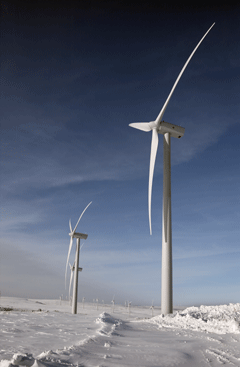
: A Vesta V80-1.8MW Turbine windfarm in Evanston, WY (Courtesy of Vesta Wind Systems A/S)
GELLERMAN: These days, you don’t have to be a weatherman to know which way the wind is blowing. You might want to be an investment banker. That’s because the wind turbine business is booming. Demand is so high for wind power there aren’t enough wind turbines to go around.
Joining me is Matthew Patsky. He’s partner and portfolio manager with Boston-based Winslow Management Company, which manages the Winslow Green Growth Fund focusing on companies that address environmental issues. Matthew, welcome.
PATSKY: Thank you, Bruce.
GELLERMAN: Boy, the demand is so big for these things. I was reading the United States went up fourfold since 2000.
PATSKY: Yeah. It’s been growing very rapidly. In 2006, we were up 26 percent and we’re growing a little bit faster this year, up 27 percent.
GELLERMAN: Why is that?
PATSKY: The economics of wind are very compelling. Particularly in an environment of rising fossil fuel prices, the economics have only become more compelling as technology improvements have lowered the cost in producing electricity using wind, and obviously the cost of producing it via fossil fuel has been rising.
GELLERMAN: But in Europe, it’s been big for decades, and it’s only recently here.
PATSKY: In Europe there was much more forward thinking federal government initiatives by a lot of the countries in Europe to promote renewable energy and so you saw, for example, Germany get far ahead of us in terms of use of wind. And basically broadly in Europe there’s been a lot more use of wind power for producing electricity, and we were slower to pick up on that trend.
GELLERMAN: Well, the demand is so high now, they don’t have enough wind turbines to go around.
PATSKY: You’re seeing a couple factors in both the U.S., which is really turning to wind now, in a very major way, with lots of demand and of course China and India, also coming on as part of their energy demands, picking up wind as one of the resources they’re trying to implement. You’ve got such tremendous demand, everybody was caught without enough supply of wind turbines, and all the wind through the manufacturing channel there’s bottlenecks and a need to increase capacity.

A Vesta V90-3.0MW generator being lifted for installation on a tower in Nakskov, Denmark.(Courtesy of Vesta Wind Systems A/S)
PATSKY: Right. As they’ve been building them larger and larger, getting more efficient, they’ve also had all sorts of issues. The old blades were made of fiberglass. You actually with the new windmill blades-- because of the blade size in these wind turbines you can’t even make these blades out of fiberglass anymore, you need carbon fiber. There’s a shortage of carbon fiber. And that’s because there’s such a demand for the carbon fiber for use in applications of wind power.
GELLERMAN: And you would think that it’s such a simple looking device. You know it just goes around.
PATSKY: Right.
GELLERMAN: But it’s very complex, a lot of parts.
PATSKY: It is a complicated device and an expensive device, but becoming increasingly economic, and therefore, you know, there’s not only just regulatory reasons why there’s more and more demand for them; it’s because industry is realizing that there’s an economic reason to use them. For example, Florida Light and Power now producing almost 20 percent of their power from wind.
GELLERMAN: And there are states that require a certain amount of power—I think 20, or 21 states that require a certain amount of power be supplied by alternative energy.
PATSKY: Right. Increasingly states have put in place legislation requiring that there be a move toward a certain portion of their electricity needs coming from renewable, and those renewable standards are indeed helping drive some of this growth too.

A Vesta V80-1.8MW Turbine windfarm in Evanston, WY(Courtesy of Vesta Wind Systems A/S)
GELLERMAN: So right now we have this bottleneck on the parts to make these turbines.
PATSKY: Yup.
GELLERMAN: When does that clear up?
PATSKY: I mean you have Vestas building new facilities, which is a wind turbine maker. You have Zoltek which we know well which is a carbon fiber manufacturer has been adding capacity in its facilities, particularly in Hungary. So, you’re really trying to catch up with demand by adding capacity. Now, is there truly ever a catch-up in the near term? I can’t tell. I know that there’s more capacity coming on in ’08 with both of those companies.
GELLERMAN: Wind is bigger than solar.
PATSKY: Wind is bigger than solar because it’s more economic. And of course geothermal which is another alternative energy source is even cheaper. You know you’re going to see some very rapid growth of a lot of different categories of renewable energy over the next decade and wind is certainly seeing the biggest growth because it has so many applications. They can be put in a lot of different places. And obviously the wind farms that you are seeing are producing a lot of electricity with those larger and larger wind turbines.
GELLERMAN: But even with all this growth in the wind industry, it still supplies only a small fraction of the energy that’s consumed in the United States, right?
PATSKY: In the U.S., 50 percent of our energy comes from coal. Less than three percent is coming from wind.
GELLERMAN: So, what would it take for wind power to cover a much greater proportion of our energy use?
PATSKY: Well, you’re seeing 25 percent plus growth now. You’re likely going to see acceleration as some of the capacity issues are eased. And with that you will see continued growth in the market share of energy that’s produced via wind in the U.S. But you’re coming off such a small base, this could go on for many years. You know you could see acceleration to 50 percent and still have that continue for three, four, five, six years and we’re just sort of beginning to make a dent in fossil fuel use.
GELLERMAN: Well, Matt Patsky, thanks for coming in.
PATSKY: Thanks Bruce, it’s my pleasure.
GELLERMAN: Matthew Patsky is partner and portfolio manager with Boston-based Winslow Management Company.
[MUSIC: Radiohead “Like Spinning Plates” from ‘Amnesiac’ (Capitol Records – 2001)]
GELLERMAN: Coming up: heading for the hills of New Zealand. Tuvaluans flee the advancing sea. Stay tuned to Living on Earth.
Related links:
- Winslow Management Company
- Vestas – The largest wind manufacturer in the world
- General Electric’s Wind Turbine Division
Early Signs: New Zealand’s Climate Refugees

Tuvaluans perform traditional song and dance - called fatele - in a West Auckland meeting hall. (Photo: Durrell Dawson)
GELLERMAN: It’s Living on Earth. I’m Bruce Gellerman. Today we turn to our archives and our award-winning series “Early Signs: Reports from a Warming Planet.” Living on Earth, along with the U.C. Berkeley Graduate School of Journalism and Salon dot com, set out to document places around the world where the effects of climate change can already be seen. One of those places is the tiny Pacific island nation of Tuvalu. Just three feet above sea level, the islands are expected to eventually disappear off the face of the earth, drowning as global warming melts the ice sheets, raising the level of the oceans. Some Tuvaluans see themselves as climate refugees and are already abandoning their islands, moving their communities to higher ground in a new land. Alexandra Berzon reports from New Zealand.
[TUVALU MUSIC FROM PARTY; SINGING AND DRUMMING]
BERZON: It’s the biggest party of the year for one of the nine islands that make up Tuvalu, Nanumea, the annual celebration of the day European missionaries brought Christianity to the island. Families gather on mats and feast picnic-style on foods like funafuna, donuts filled with jam, taro drenched in coconut milk, egg fu young, and buckets of KFC chicken. Then competing groups of elders and youth take turns dancing, singing and drumming on a big wooden box into the early hours of the morning, while onlookers stand up and announce jokingly which group they liked best.

Tuvaluans perform traditional song and dance - called fatele - in a West Auckland meeting hall. (Photo: Durrell Dawson
BERZON: Tuvaluans have been performing these songs for generations, across their string of low coral atolls. But this event is not taking place in Tuvalu. Instead, we’re 2,000 miles away in Auckland, New Zealand. And here, surrounded by tradition, sits a group of young girls looking unimpressed.
AMY: What’s your name?
BERZON: Ali. What’s your name?
AMY: Amy!
BERZON: Nice to meet you, Amy.
AMY: Nice to meet you, Ali.
BERZON: Amy is seven and her favorite song is “My Humps” by the Black Eyed Peas.

Drummers pound on a straw mat laid over a wooden box as Tuvaluans in Auckland perform traditional dances. (Photo: Durrell Dawson)
BERZON: Here in this West Auckland suburb where many Tuvaluans have settled, you won’t find an ocean outside the door, coconut trees on the shore or taro in every garden. You’re more likely to encounter malls and wide boulevards. Over the last decade, the islanders have come here for many reasons – better jobs, college, overcrowding on the islands – and to escape what many see as a threat of sea level rise, caused by global warming.
[BREAKFAST SOUNDS]
P. TANIELA: That’s me. Prepare the breakfast every morning for my family.
BERZON: Penisita Taniela arrived in New Zealand with a small suitcase and a carton of fish.
He lives now in the western working-class suburb Ranui in a three-bedroom home with his wife, children, father, stepmother, and sisters.
[SOUND OF KIDS]
BERZON: Peni’s living room, like most Tuvaluan homes, contains no furniture – just hand-woven straw mats that his father and step-mom sleep on. Shell necklaces and family photos line the walls. As Peni fries pancakes on a leisurely Saturday morning, his two young kids ride around the living room on a shiny new bike with a squawk box.
[SOUND OF LOUD BELL]
BERZON: Nearly twenty years ago, when Peni was just a teenager living on his family’s land, he remembers hearing that some day the sea would rise and drown his island.
P. TANIELA: Just my dad said, ‘Oh, don’t worry about that. We are just waiting for many years.’ Not, not now.
BERZON: But over time, Peni and his family noticed changes – high tides getting higher, beaches eroding, water coming up through the soil. Here’s his father, Telaki Taniela.
T. TANIELA: As a kid we used to play on the beach. We see the high tide and all that but in recent years high tide gone over beyond what it used to be. I said to myself, yes, the scientists really are telling the truth. I managed to build two houses there. I just got up and go and left it behind to my family there.
BERZON: Gauges in Tuvalu indicate the sea has risen an average of five and a half millimeters per year in recent years. That’s consistent with average worldwide sea level rise. But scientists say there are also other local explanations, natural and human-caused, for the changes islanders have observed.
The greater worry is for the future. The Intergovernmental Panel on Climate Change, which represents the consensus of 2,000 scientists, predicts that over the next 50 to 100 years global warming will cause oceans to rise up to three feet, and possibly much higher, depending on the melting of the Antarctic and Greenland ice sheets. Tuvalu, along with a handful of other islands, is particularly vulnerable because its islands are low-lying and narrow – no more than three feet high in many spots.
Some New Zealand scientists argue that because islands are not static lumps of dirt, they will shift with the tides and naturally build themselves up further to withstand a rising ocean. But even those who believe this – and their view meets skepticism from other scientists – even they say the islands will probably become uninhabitable. For many Tuvaluans, this is not a risk they’re willing to take.
T. TANIELA: I don’t want to get up in the morning and find myself under water.
[SOUND OF VIDEO FROM TUVALU]

Penisita Taniela cooks breakfast with his step-mother and wife on a leisurely Saturday morning. (Photo: Durrell Dawson)
P. TANIELA: I show my kid that movie from Tuvalu and say, ‘Ohhhh, Tuvalu, Tuvalu, where is Tuvalu?’ They don’t know where is Tuvalu. And say, maybe they will go there one time. Maybe one day we go there and see the island.
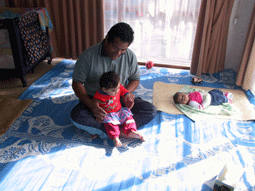
Telaki Taniela plays with his grandaughter in his living room, while his youngest child looks on. (Photo: Durrell Dawson)
T. TANIELA: When I was young I was told that there are two main things you have to learn if you want to live in Tuvalu: how to climb the coconut tree and how to fish. If you know these two then you will live. But in New Zealand, no, you have to have an income. It’s a very challenging place. Everything you do, it costs you money.
BERZON: Though in a way he was driven out, most of the time Mr. Taniela looks forward instead of back. He’s pleased to have started a business last year that finds temporary migrant labor for New Zealand companies. His son, Peni, like many Tuvaluans, started out in Auckland’s strawberry fields and packing plants.
[SOUND OF PACKING PLANT. WOMEN SINGING]
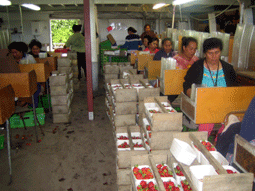
This strawberry packing plant in West Auckland has become a community hub for Tuvaluan women. (Photo: Alexandra Berzon)
WOMAN: I meet my friends here, and all the Tuvaluan ladies here.
BERZON: Here, women sit behind tiny desks rapidly sorting through strawberries, putting the good ones in plastic containers and throwing the bad down a shoot into a pile that will become jam.
[SOUND OF KATALINA KOFE TALKING IN TUVALUAN]
BERZON: Katalina Kofe is wearing a red sarong over black sweat pants, with a pink flower in her hair. She’s been working in the fields in the morning, and packing berries in the afternoon.
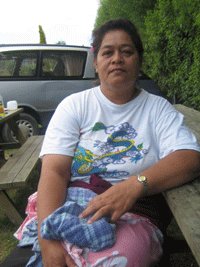
Katalina Kofe on her lunch break at the strawberry packing plant. She misses Tuvalu, but says she had to move to New Zealand for her family's safety. (Photo: Alexandra Berzon)
[SOUND OF RECITATION IN CHURCH]
BERZON: On Sundays, the Congregation Christian Church of Tuvalu gathers to recite verse and sing hymns beneath framed photos of middle-aged white men in this rented Lion’s Club Hall.
[HYMN]
BERZON: In1998, Reverend Suamalie Iosefa came to New Zealand to set up the Auckland branch of the church. He is 48 but has the aura of a much older man, an elder. He spreads himself thin attending meeting after meeting to try to better the community, and feels some responsibility for preserving Tuvaluan culture here.
IOSEFA: Teaching the children in Sunday school in the language, our services in the language. But the younger children they speak fluent English, not like us.
[SOUND OF PEOPLE SHUFFLING OUT. SOUND OF VACUUM CLEANER]
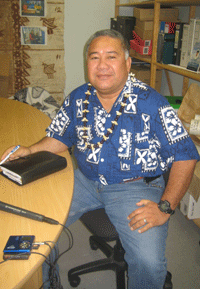
Reverend Suamalie Iosefa in his Pasifika Healthcare offices. (Photo: Alexandra Berzon)
TAMAIO: I just want to migrate to migrate, no threatening reasons.
BERZON: Like some other religious Tuvaluans, Vaililo doesn’t believe in global warming because he doesn’t think God would ever let anything bad happen to Tuvalu.
TAMAIO: I don’t believe Tuvalu will submerge, no. We do adhere to the religious belief that God will help the people in his country, Tuvalu.
BERZON: But Tuvaluans are of many views. Reverend Suamalie says God and science are speaking with one voice, issuing a warning that humans must follow.
IOSEFA: Noah listened because God said build the ark. But do we listen? And I think the church has to have more understanding of science and what the world is all about.
BERZON: He gives the example of a Tuvaluan who has come to New Zealand without learning the rules of the road, and then blames God when he gets hit by a car crossing the street.
IOSEFA: And then people say, ‘God has taken him.’ No, he is not a silly God. But it’s you who is silly, you don’t know the rules and you were hit by the car in the road.
[RADIO SHOW PROMO]
BERZON: Fala Haulangi’s weekly radio show has become a venue for these differing views, a place to discuss the hot button issues and the lighter fare.
[FALA TALKING ON AIR]
BERZON: She is a union organizer by day, with a wild tuft of highlighted hair and over-the-top hand gestures. We talked at a Starbucks in a West Auckland mall.
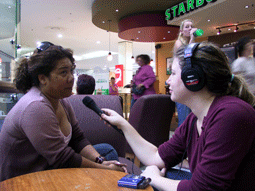
Alexandra Berzon interviews Tuvaluan radio show host Fala Haulangi at a Starbucks in an Auckland mall. (Photo: Durrell Dawson)
BERZON: Fala and Suamalie, along with international environmental activists, argue that Tuvaluans and others in a similar predicament should be treated like refugees and given immigration rights and other refugee benefits. This tiny nation was among the first on the globe to sound the alarm, trekking from forum to forum to try to get the world to listen. New Zealand did agree to take 75 Tuvaluans a year as part of its Pacific Access Category, an agreement made in 2001. Koloa Talake knows all about this. He was Prime Minister of Tuvalu at the time.
TALAKE: You can see the sea from here…
BERZON: Mr. Talake now lives across from the beach on a remote peninsula north of Auckland. He says that decision to make it easier for his own citizens to move away from his country was difficult, but necessary.
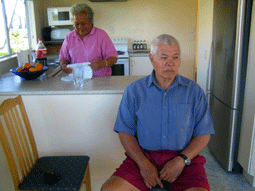
Former Tuvalu Prime Minister Koloa Talake stares at at the beach across the street from his home on a remote peninsula north of Auckland. (Photo: Alexandra Berzon)
BERZON: And now that Tuvaluans are living in New Zealand, they’re beginning to have a voice here, too.
CARTER: My name’s Chris Carter. I’m a member of parliament. I represent perhaps the largest number of Tuvalu people in the parliament because the majority of community live here in western Auckland. The government recognizes very much that Tuvalu particularly, being an atoll state, is very vulnerable to climate change and to rising sea levels. In fact, our prime minister has told the prime minister of Tuvalu that if the worst comes to the worst we will take the entire community. All I can say is that there's an understanding between our two governments that New Zealand will respond to the needs of Tuvalu if the circumstances become critical. And how could we not?
BERZON: That agreement to take the entire population if there’s an environmental crisis is unofficial and unenforceable. And to some politicians, including Minister of Parliament Pita Paraone of the New Zealand First Party, it is the wrong policy for New Zealand.
PARAONE: That responsibility shouldn’t just fall on New Zealand. Tuvaluans need to be aware that there are other nations in the Pacific Basin that could just as well accommodate them, probably even better than we can.
BERZON: And now, the current Tuvaluan government says this disagreement doesn’t matter because finding a place for refugees doesn’t address the underlying problem.
SOPOAGA: I think these things are quick-fix approaches.
BERZON: That’s Enele Sopoaga, Tuvalu’s ambassador to the United Nations.
SOPOAGA: We are just running away from the problem. Tuvaluans want to live in their own islands forever. This is a global problem. All the low-lying coastal areas are going to be affected. Now you tell me whether the world is ready to evacuate everybody and relocate them. There is a challenge to reverse and address climate change, and I think the world should focus on that.
[SOUND OF WAVES]
BERZON: The day after the feast celebrating the coming of the missionaries, Nanumeans gather bleary-eyed at a beach party up the coast. Teenagers and twenty-somethings in last night’s sarongs play traditional games, including more nuanced forms of Duck Duck Goose and volleyball. The older people lie out on mats and eat last night’s food.
[SONG]
BERZON: One family sings a Tuvaluan song about the islands’ only ship, a gift from the Japanese government. Seven-year-old Amy runs from the waves.
AMY: I just ask my auntie and she say yes, so I just went. I’m cold. (chattering)
BERZON: This party might be a close approximation of daily life in Tuvalu, but here in Auckland, it’s just a holiday. Silou Temoana is washing the sand out of her thick hair. She believes reports that the sea could overtake the islands but she just can’t imagine a world without Tuvalu in it.
TEMOANA: That’s unthinkable. I never thought of that, because in my mind it’s going to be there forever.
[SONG]
BERZON: For Living on Earth, this is Alexandra Berzon.
GELLERMAN: “Early Signs” is a collaboration of the UC-Berkeley Graduate School of Journalism, Salon dot com, and Living on Earth. To learn more about the climate refugees of Tuvalu and see photos of their life in New Zealand - visit our Web site, Living on Earth dot org. That’s Living on Earth dot O-R-G.
[TUVALUAN MUSIC]
 |
 |  |  |
Related link:
Salon Dot Com
Emerging Science Note/Lawnmower No More
GELLERMAN: Just ahead: robots past, present and future. First, this Note on Emerging Science from Emily Taylor.
TAYLOR: The grass is always greener, right? Well, thanks to recent research at the Howard Hughes Medical Institute in Maryland, you may soon be able to have green grass and get rid of that noisy, polluting lawnmower to boot.
Researchers led by Joanne Chory were able to map the signaling pathway of a crucial hormone in plants that regulates growth and development, thus creating grass that stays green and never needs mowing. Now they believe they can manipulate the pathway and control a plant’s stature and its yield. The group of hormones the team examined are called Brassinosteroids, and they act as a chemical messengers of plant development. Without them all plants would be infertile, tiny dwarves.
By limiting the effect of brassinosteroids, Chory and her team believe they may be able to create a genetically modified strain of dwarf grass that stays green all the time. And by enhancing the amount of the steroid they may be able to create types of plants that would yield greater amounts of seeds.
Other studies have shown that brassinosteroids can regulate their own expansion in nature, allowing plants to adapt to their growing conditions in a particular environment. The mainstream effects of this new research could drastically change the face of horticulture in the future, producing sturdier, more fruitful crops.
That’s this week’s Note on Emerging Science, I’m Emily Taylor.
Related link:
Howard Hughes Medical Institute Press Release
GELLERMAN: And you’re listening to Living on Earth.
ANNOUNCER: Support for the environmental health desk at Living on Earth comes from The Cedar Tree Foundation. Support also comes from the Richard and Rhoda Goldman Fund for coverage of population and the environment. This is Living on Earth on PRI, Public Radio International.
Energy Brat?

Youth Radio reporter Antony Jauregui and his younger brother Alexis battle over the remote control.
GELLERMAN: It’s Living on Earth. I’m Bruce Gellerman. With the prices of gas and oil sky high, many families are trying to conserve energy so that they can avoid costly bills. But it’s not a concern for your average teenager. For example, take Youth Radio’s Antony Jaureguí. He readily admits he didn’t think much about conserving energy. After all, he grew up in sunny Southern California. But on a recent trip to his parents’ hometown in Mexico, he began to question why he never questions his energy use.
[APPLIANCE SOUNDS]
JAUREGUI: This is the sound of convenience in my house. Microwave, television, computer, stereo. We use these appliances a lot. My 14-year old brother Alexis is the main culprit. He leaves the lights on and appliances unattended. I try not to waste that much energy. I caught him upstairs playing on the computer and a hand-held video game- called a DS- at the same time.
ALEXIS: I’m not on the computer and the DS at the same time only the computer and TV.

Youth Radio reporter Antony Jauregui and his younger brother Alexis battle over the remote control.
ALEXIS: No that’s crazy. You’re the one who does it!
JAUREGUI: I use it more than you?
ALEXIS: Of course. You sleep with the radio on and you don’t turn it off until the morning!
JAUREGUI: That’s not true
ALEXIS: You told me 5 times! (laughs)
JAUREGUI: Ok, maybe we both use more energy than necessary. But my parents have tried to teach us to be mindful about energy. They grew up in a totally different era in a small town in Mexico.
DAD: I used to pick up some manure of the cow and also the manure of the donkeys.
JAUREGUI: Here’s my dad talking about his first lesson in energy.

Youth Radio reporter Antony Jauregui says he and his father have different perspectives on energy consumption, because his dad grew up in a rural part of Mexico.
[SOUND OF GAS VENDOR]
JAUREGUI: That’s the gas delivery man in my dad’s hometown- Jalostitotlan. He's saying 'gaaaaaaa-aaaaaassss'. He’s shouting out the window of his truck to sell tanks of gas to the townspeople. This summer, I visited my family there and learned about energy in a new way.
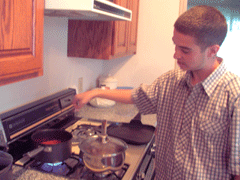
Youth Radio reporter Antony Jauregui prepares a meal using the gas stove in his house. Before his trip to Mexico, Antony says he never though about how much energy he uses on a daily basis.
[GREETINGS IN SPANISH]
I stop by my neighbors to ask what’s it all about? The person who answers in an elderly lady named Yermina Gonzalez.
YERMINA: Es bueno el systema porque ahorra uno a dinero se conserva la agua como 3 a 4 dias quando el tiempo esta malo y eso es lo que nosotros hemos visto. Quando el tiempo esta bien siempra hay agua caliente. Valle tener un sistema asi un systema solar.
JAUREGUI: She tells me the panels are her solar-powered water heating system. She says that over the past 25 years she has conserved not only gas, but also tons of money.
It seems like energy use is on peoples’ minds here more than in LA. This makes me wonder: am I an energy brat? When I’m home in LA, I even complain about going outside to put my clothes in the washing machine. Here at my grandma’s in Jalisco, I’m getting used to being the washing machine.
JAUREGUI: (tape) Now I’m doing laundry. Here it’s all hand washed. You get the water from this water pipe, it’s like inside the toilet, it’s like a little pump and the water runs out. And I just scrub. [Sigh]
DAD: When you go through trouble getting something, then you really appreciate what you have.
JAUREGUI: I’ve always had energy at my fingertips, so I haven’t really thought about where it comes from and how much I use. My parents have had it harder. And maybe that’s where they get their mentality about energy.
DAD: Like I don’t know if you remember where your mother used to live on the top of the hill. She used to go down there to get the water. She had to walk a lot to get some water so now when you guys or me even use a lot of water, she really gets upset because she knew how hard it was to get the water and now that we have the water sometimes we waste it.
JAUREGUI: I always thought that my mom was just tripping on me whenever I left the water running. But now I understand the chill that must run through her spine when she sees me waste water. Now that I’m back at LA, I am more dedicated to saving energy. Not only do I turn off the lights, but I’ve even caught myself looking through articles on energy conservation and careers. I used to think energy was only an issue in my house, but now I realize that it’s an issue affecting the whole world.
For Living on Earth, I’m Antony Jauregui.
GELLERMAN: Our story was produced by Youth Radio.
Related link:
Youth Radio
The Future of Robotics
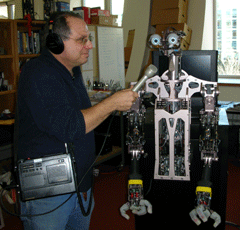
(Photo: Emily Taylor)
GELLERMAN: Increasingly, living on earth means living with robots. Sharing the planet with ever-more intelligent machines that perform tasks from the mundane, like the robo-lawnmower that cuts your grass, to the highly specialized like robo-docs that do surgery. The word “robot” comes from the Slavic word “robota” or work, and was first used by Czech science fiction writer Karel Capek in 1921. Ever since, robots have stirred and captured our imaginations.
[FAMOUS ROBOT MOVIE MONTAGE FEATURING: "Robbie The Robot" from 'Forbidden Planet (MGM - 1956),
"HAL 9000" from '2001: A Space Odyssey (MGM - 1968),
"Robot" from 'Lost in Space: The Movie (New Line - 1998),
"C-3P0" and "R2-D2" from 'Star Wars: Episode IV - A New Hope (LucasFilm - 1977),
Rodney Brooks sound clip from 'Fast, Cheap & Out of Control' a film by Errol Morris (Sony Pictures - 1997)]
GELLERMAN: Robosapiens, life-like robots that obey our every command are still the stuff of Hollywood. But at the just concluded consumer electronics show in Las Vegas, robots for the home were being hailed as the next big thing. It's an industry poised to amaze.
[ROBOT SOUNDS]
To see first hand where things are headed check out MIT's humanoid robotics group. Here on the Cambridge, Massachusetts campus, grad student Aaron Edsinger has just put the finishing touches on one of the world's most advanced robots.
EDSINGER: This is my PhD work. This is a, a humanoid robot named Domo.
GELLERMAN: Domo means…?
EDSINGER: Domo means thanks in Japanese but it’s also the name of a song, Domo Arigato, Mr. Roboto.
GELLERMAN: Domo looks a lot like a human. It’s got eyeballs and it’s looking at me. And it’s got this arm with biceps, triceps. I mean put a skin over it and…

Bruce Gellerman chats up Domo.
(Photo: Emily Taylor)
GELLERMAN: Is it perceiving me?
EDSINGER: It can. At the moment the visual cortex is sort of switched off. But when everything is running it can see you, it can interact with you, reach to you, respond to your physical contact. What you see here is that I can grab the arm and it can sense that and it can respond to it when I push on it. So, it’s actually sensing a person’s interaction with it. And the idea is that it’s sort of a partner robot. It works with you to do something, a manual task.
GELLERMAN: Well it’s missing an important part. It’s got no legs.
EDSINGER: No legs, yeah. Legs, legs are hard. We don’t focus on the mobility so much although I think that’s the next obvious step.
GELLEMRNA: That would be major Domo.
EDSINGER: Major Domo, yes.
GELLERMAN: So, what’s the computing power of this?
EDSINGER: This is actually about 15 computers that go into running the robot when everything is turned on. Now most of that is for computer vision. Motor control actually doesn’t take a whole lot of computation.
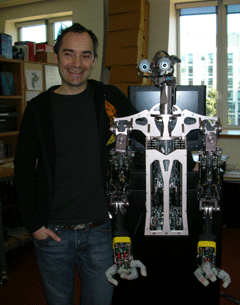
Aaron Edsinger with his robot Domo. (Photo: Emily Taylor)
GELLERMAN: When you were working and building this, did you ever think it was, well another person? Did you ever react to it and start asking it things and expecting things?
EDSINGER: Sure, yeah. You know that it’s a piece of metal and motors. And you know all the code that’s going on behind it but every now and then it acts in a way that you don’t expect. At a certain level it’s hard to know what’s going to happen to it, how it’s going to respond because its behavior is not scripted. It’s really responding to its environment and reacting to that. So sometimes you get that glimpse of it being very life-like.
GELLERMAN: Well, thank you very much congratulations.
[MUSIC: Styx “Mr. Roboto” from ‘Kilroy Was Here’ (A&M – 1983)]
GELLERMAN: Grad student Aaron Edsinger built Domo at MIT’s computer science and artificial intelligence laboratory. The lab’s director is Rodney Brooks. He’s also chief technology officer of Irobot, a company that produces robotic vacuum cleaners. You might have seen Brooks in the movie Fast Cheap and Out of Control playing himself, an eccentric designer of robots.
MOVIE: When I switched the things on the lights flashed and the machine came to life. It moved! Some people believe that we are going to replace ourselves by building these machines and that may be.
GELLERMAN: Rodney Brooks’ office in a space-age building at MIT is a study in controlled chaos. We sit on a couch opposite a wall with a poster of Fast Cheap and Out of Control, and a photo of Brooks and a robot playing with a slinky.
BROOKS: Yeah, that was a robot named Cog, a humanoid form but no legs. And we were really interested, and still are, in robots with arms that are safe to be in the same space as whereas a robot in a factory with arms, you don’t want to be near. So, trying to make robots that are safe to interact with so that ultimately we can have robots manipulating things in the world, doing stuff with us, partnering with us. And for us Baby Boomers, this is going to be important for us in our old age.
GELLERMAN: Oh really, why?
BROOKS: Well, if you look at the demographics of the world there’s going to be many many more elderly compared to working age people, same problem with our social security financing. And where are we going to get all the people to help us in our homes and in our hospitals, we’re going to have to have more robotics help and assistance.
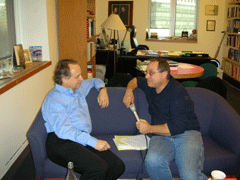
Bruce Gellerman (right) and CSAIL Director Rodney Brooks discuss the future of robotics. (Photo: Emily Taylor)
BROOKS: Well, we’re not there yet, but I think we’re making good progress towards it. You know, we’re starting to see robots in people’s homes. Now, by the standards of 30 years from now those robots are fairly simple. The home cleaning robots, my company Irobot happens to be the biggest manufacturer of them.
GELLERMAN: You’re making, basically vacuum cleaners.
BROOKS: Yeah but they’re robotic vacuum cleaners. You press the clean button and you walk away and they clean the house.
[SOUND OF ROBOTIC VACUUM CLEANER]
GELLERMAN: That thing really works!
BROOKS: Yeah, of course it works! (laughs)
GELLERMAN: But I’m thinking, you know, the Jetsons, where they have Rosie the robot.
BROOKS: Well, we’re not going to have Rosie any time soon. But you gotta think, what were computers like 30 years ago? What are computers like now?
GELLERMAN: Well, we’re in the William H. Gates building at MIT. And Bill Gates has an article in the January issue Scientific America in which he talks about the future of robots. And he says they’re going to be as ubiquitous as computers.
BROOKS: Yeah, he makes the analogy between robots today and computers when Microsoft got started and his company was one of the leading forces in changing what computers could do.
GELLERMAN: So, what do we need to accomplish between where we are now with your vacuum cleaner robot and robots that kind of have arms that swing and paint and where are we going to be in 10 years?
BROOKS: Well, I say that there’s 2 really critical things that we as researchers should be working on at the universities. We need the visual object recognition capabilities of a two-year-old child and the manual dexterity of a 6-year-old child. They are the 2 capabilities that I think are important to go after in the research demand right now. We’re making progress on both of them although both have a long history of not necessarily great success over the years.
GELLERMAN: People think about robots, I think they think about humanoid robots, that is things that look like us that we create in our own images. When you think robot is that what you’re thinking of?
BROOKS: I could believe either way. It could be that we want robots with our own form or we could have robots with other forms. But we will want to be able to interact with them socially. Let me tell you what I mean by that. We interact with our dogs socially. We know what our dog is looking at, what the dog is paying attention to. Our dogs know what our gaze direction is. They understand us. We understand them. I think we’re going to need that intuitive understanding of what our robots are trying to do. And our robots are going to need the intuitive understanding of what it is we’re trying to do and then co-exist with us and help us. And if they don’t do that, no ones going to buy it.
GELLERMAN: When we design these robots it seems like we design them in our own image. And that when we try to give them intelligence and maybe even consciousness that it’s really not saying what is a robot. We’re asking the question what is human?
BROOKS: Well, that’s I think one of the biggest drivers for us in my research lab here has been what is human and trying to understand that by building models. For me the most remarkable thing has been how simple the social interaction parts are to build. Now what’s hard is object recognition, manipulation, the stuff that two-year-olds can do.
GELLERMAN: So, now look out 100 years. I know it’s the stuff of science fiction. Are we going to have robot people?
BROOKS: Well, we don’t have robot birds yet. We’ve got really good machines that fly but we don’t have machines that fly like birds. So, I think that we get the essence, but whether we go to the trouble of making it identical to a human, I don’t know. Now could it be 100 years from now that we have robots that are truly intelligent and true beings? In principle, absolutely. You know, I as a sort of strong scientist think that we are machines. You and I are machines. We’re made of biomolecules. Biomolecules interact through the laws of chemistry and physics. So we are machines. So in principle it seems that we should be able to have machines built out of other stuff, which are intelligent like us. Now another question is, are we humans smart enough to build such machines? That’s an open question. You know, you look at a raccoon. A raccoon is very dextrose with its hands. You know it can unlock things and get into places and stuff. But I don’t know any one who’s looked at a raccoon and thought, hey one day that raccoon is going to build a robot raccoon just like itself.
GELLERMAN: (laughing)
BROOKS: So you can imagine the guys from Alpha Centauri, from another solar system, are up in their UFOs they’re looking down, and they’re looking at MIT and they say, “Oh look at those little professors there. They’re going to build robot versions of themselves. Aren’t they cute!
GELLERMAN: It seems that this is as much philosophy as physics.
BROOKS: It’s a mixture of the two. And therefore it’s very murky. And therefore many scientists feel very uncomfortable about it.
GELLERMAN: How do you feel about it?
BROOKS: I feel fascinated. What could be more fun, except going to space?
GELLERMAN: Dr. Brooks, I want to thank you very much.
BROOKS: Thank you.
Related links:
- MIT’s Computer Science and Artificial Intelligence Laboratory
- Aaron Edsinger-Gonzales’s website
- “A Robot in Every Home” by Bill Gates in Scientific American
- Rodney Brooks’ iRobot Corp.
- Consumer Electronics Show website
Living on Earth wants to hear from you!
Living on Earth
62 Calef Highway, Suite 212
Lee, NH 03861
Telephone: 617-287-4121
E-mail: comments@loe.org
Newsletter [Click here]
Donate to Living on Earth!
Living on Earth is an independent media program and relies entirely on contributions from listeners and institutions supporting public service. Please donate now to preserve an independent environmental voice.
NewsletterLiving on Earth offers a weekly delivery of the show's rundown to your mailbox. Sign up for our newsletter today!
 Sailors For The Sea: Be the change you want to sea.
Sailors For The Sea: Be the change you want to sea.
 The Grantham Foundation for the Protection of the Environment: Committed to protecting and improving the health of the global environment.
The Grantham Foundation for the Protection of the Environment: Committed to protecting and improving the health of the global environment.
 Contribute to Living on Earth and receive, as our gift to you, an archival print of one of Mark Seth Lender's extraordinary wildlife photographs. Follow the link to see Mark's current collection of photographs.
Contribute to Living on Earth and receive, as our gift to you, an archival print of one of Mark Seth Lender's extraordinary wildlife photographs. Follow the link to see Mark's current collection of photographs.
 Buy a signed copy of Mark Seth Lender's book Smeagull the Seagull & support Living on Earth
Buy a signed copy of Mark Seth Lender's book Smeagull the Seagull & support Living on Earth

